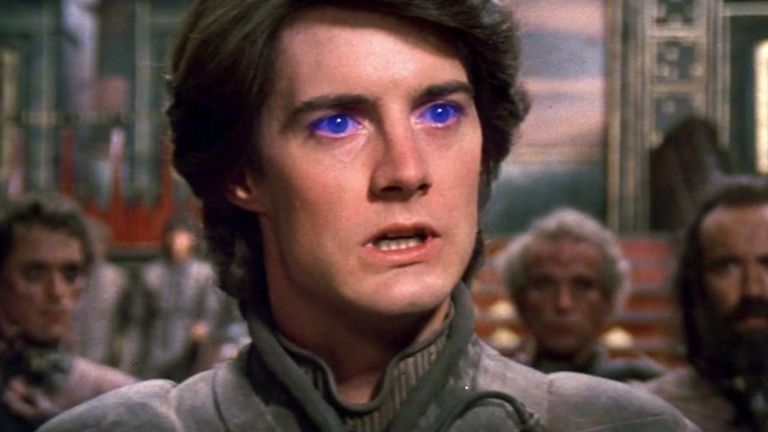Lost Dune II Script Promised a Way More David Lynch Experience
A recently discovered script for Dune II reveals are more David Lynch style take on Frank Herbert's sequel Dune Messiah.

Like the piscine Guild Navigator who gets wheeled out in a tank at the start of the movie, David Lynch‘s adaptation of the Frank Herbert novel Dune is neither fish nor fowl. Lynch gets to play with some rather dense world-building, but Herbert’s critique of charismatic leaders gets pushed to the side while the demands of ’80s sci-fi fantasy don’t allow the director to create what would later become his signature dream states. As a result, Lynch’s Dune pleased no one, least of all Lynch himself. And while the film has its fans, especially in light of Denis Villeneuve‘s more faithful blockbuster, it remains an outlier in both Lynch’s oeuvre and in the history of Dune adaptations.
Still, the legend goes that if studio meddling and post-production issues not come to bear, Lynch would have been able to put more of his stamp on the sequel Dune II. Although many knew that Lynch initially planned to make a second and even third movie in the franchise, adapting the Herbert novels Dune Messiah and Children of Dune, we’ve known little about what those movies would actually look like.
But thanks to a partial copy of the Dune II script recently recovered by Max Evry, author of A Masterpiece in Disarray: David Lynch’s Dune—An Oral History, we can see what Lynch had in mind. Writing for Wired, Evry revealed that he found a copy of the “half-script” written by Lynch among Herbert’s archives at California State University, Fullerton. Although not yet finished, the script showed what Lynch intended for his take on Dune Messiah.
Released in 1969, Dune Messiah follows the reign of now-Emperor Paul Atreides (portrayed by Kyle MacLachlan in the Lynch movie and by Timothée Chalamet in the latest version), who has accepted his role as the messiah Muad’Dib and leads a bloody jihad across the galaxy. Some of Paul’s old reluctance still remains, but his gift of pre-cognition makes him certain that his path is the best for humanity despite the millions of lives lost.
While Paul and his concubine Chani (first Sean Young, now Zendaya) try to unsuccessfully conceive a child, a confederation of enemies comes together to undermine him. In addition to the Bene Gesserit Reverend Mother Mohiam and representatives from the Spacing Guild, the conspirators include Paul’s wife Princess Irulan (Virginia Madsen in 1984, Florence Pugh in Dune Part Two), the daughter of the previous emperor, Shaddam IV (José Ferrer in 1984, Christopher Walken in 2024).
For many, Dune Messiah is the disappointing sophomore release of the series. In place of the world-building of the first novel, the grand adventure of Children of Dune, or the bizarre events in God Emperor Dune and Heretics of Dune, Dune Messiah focuses tightly on palace intrigue. Most of the action happens off-page, while Herbert focuses on conversations—relayed through finger-talking as much as audible speech—and interior monologue.
Duncan Idaho, the slain Atreides warrior from the first book, returns in Dune Messiah in the form of a ghoula (a kind of clone/Frankenstein’s Monster). However, instead of resuming his fighting ways, Duncan becomes a Mentat, a human computer who consults on political and military strategy.
While the change in Duncan’s role might bore some fans of the first film, it fits right in line with Lynch’s interests. Twin Peaks, Lost Highway, and Mulholland Drive demonstrate Lynch’s fascination with dual identities and doppelgängers. He uses them to play with perceptions of reality and to unpack the varieties of self. When Duncan arrives in Paul’s court as a gift of the secretive Bene Tleilax, calling himself Hayt and advising his old friend not to trust him, it throws into disarray everything that the Atreides and the readers understood.
Furthermore, the Bene Tleilax are shape-shifters called “face-dancers,” who can look like anyone. As Evry pointed out in Wired, Lynch actually seeds the face dancers in the first film with the addition of Baron Harkonnen’s Doctor, a character not in the book Dune. In Dune II, the Doctor reveals himself to be Scytale, the face-dancer who reanimated Duncan Idaho as a ghola and is one of the primary antagonists in Dune Messiah.
After reading a copy of the Dune II script, scholar Kara Kennedy remarked, “The Bene Tleilaxu make for deliciously strange villains, right up Lynch’s alley.” But it’s not just the face dancers who fit Lynch’s interests. The script describes the strange factory-like world of their home planet of Tleilax, a mess of iron and smoke and sickly pink flesh.
As Evry told Den of Geek before the release of A Masterpiece in Disarray, Lynch’s original ending for Dune would have retained more of the skepticism of the novel, instead of accepting Paul as a rain-bringing god. “Certainly drafts of this script have almost the opposite of the ending we got,” he explained. “They have like an ocean of blood to signify the jihad that Paul has sparked. But then the ending slowly gets more and more spiritual, focusing less on the terrible thing that Paul has done.”
Dune II would have been more in this vein, melding Lynch’s metaphysics and interest in otherworldly horror meld with Herbert’s warnings about the dangers of charismatic leaders.
Like Lynch before him, Villeneuve plans to adapt Dune Messiah after Dune Part Two. And if his first Dune is any indication, Villeneuve will be more successful in bringing Herbert’s ideas to the screen, pleasing fans and thrilling general audiences. We’ll never know if Lynch’s take would have been better. But the newly found script suggests that Lynch’s Dune II could have been very much his.
